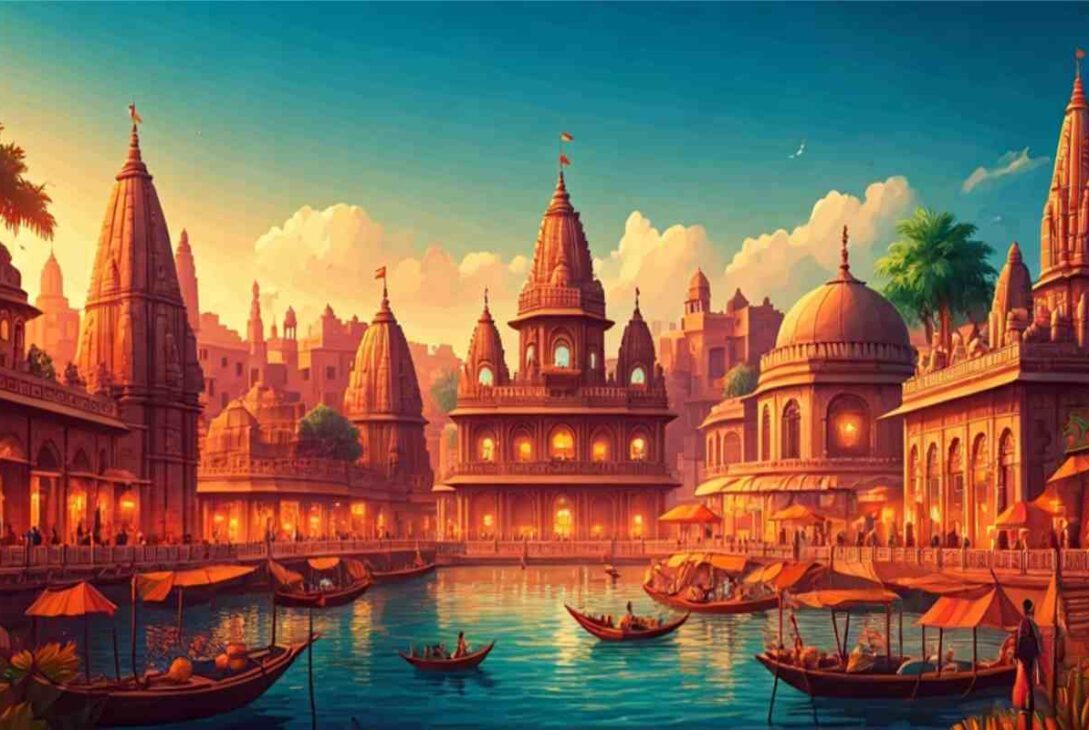Discover the Rich Culture of Rajkot, Gujarat
Key Highlights
- Rajkot City is located in the heart of the state of Gujarat and is renowned for its cultural vibrancy and historical significance.
- It’s the hometown of Mahatma Gandhi, where he pursued his early education, adding to its historical importance.
- The Rotary Dolls Museum, holding over 1,400 dolls from across the world, offers unique insights into global cultures.
- As the administrative headquarters of Rajkot district, the city has evolved into a bustling metropolitan.
- With attractions like the Race Course and Rajkot International Airport, the city is a hub of modern infrastructure combined with traditional charm.
Let’s explore Rajkot’s fascinating blend of history, heritage, and modernity.
Introduction
Nestled in the vibrant Saurashtra region of Gujarat, Rajkot City is an alluring destination that seamlessly blends tradition and modernity in the centre of the city. It stands as one of Western India’s key cultural and industrial hubs, recognised for its historical sites, exquisite cuisine, and thriving festivals. Beyond its bustling metropolitan landscape, the city has deep cultural roots and is honored as the childhood home of Mahatma Gandhi. Whether you’re drawn by its rich Gujarati heritage or its lively urban energy, Rajkot, like Mumbai, promises an unforgettable experience.
The Historical Roots of Rajkot
Rajkot’s foundation in 1612 marked the beginning of its royal journey, established by Thakur Sahib Vibhoji Ajoji Jadeja, a member of the Jadeja Rajput clan. British rule later transformed it into a prominent administrative center, housing the headquarters of the Kathiawar Agency. The princely state of Rajkot played a pivotal role in the Indian independence movement, making it an influential political and cultural epicenter.
As history unfolded, the city transitioned into a modern cultural hub without losing its historical essence, creating a fascinating blend of past and present.
Evolution from Princely State to Modern City
Rajkot’s transformation from a princely state to a modern metropolitan exemplifies its resilience. During British rule, it served as the administrative headquarters of the district, shaping its governance framework. Post-independence, it acceded to the Indian Union, marking the start of a new era in its development.
Today, the city has embraced change, featuring a rapid transit system and advancing across sectors like infrastructure and education. Despite its urban growth, Rajkot remains deeply connected to its cultural roots, evident in its unique festivals and community traditions.
Balancing tradition and innovation, Rajkot is steadily growing into one of the cleanest cities in India and the 22nd fastest-growing city worldwide, located halfway between Ahmedabad and Porbandar, embodying the spirit of progress while honoring historical significance.
Notable Heritage Sites and Monuments
Rajkot is home to captivating heritage sites and striking monuments that showcase its architectural marvels. Among them is the Rotary Dolls Museum, which houses dolls collected from over 100 countries, showcasing diverse traditions and cultures.
The Kaba Gandhi No Delo, where Mahatma Gandhi spent his childhood, offers an inspiring historical experience. Visitors can also explore Watson Museum, featuring rare artifacts from colonial times and Mohandas Gandhi High School, tied to the city’s independence story.
With historical landmarks like the majestic Jubilee Garden and Connaught Hall, Rajkot captivates both history enthusiasts and art lovers, making it a must-visit city for admirers of culture.
The Geographic and Demographic Landscape
Situated in western India, Rajkot district spans an area of 170 km², with the Aji and Nyari rivers flowing through its heart. It enjoys a strategic location along the national highway in the Kathiawar Peninsula, making it central to regional trade and tourism, particularly in December, with nearby cities like Junagadh, Amreli, Surat, and Delhi adding to its significance.
According to the Census of India, the city’s population exceeds 2 million, with Hindus forming the dominant community alongside minorities of Muslims and Jains. Rich in diversity, Rajkot’s demographic and geographic balance supports its cultural and industrial vibrancy.
Key Features of Rajkot’s Geography
Sprawling across the Kathiawar Peninsula, Rajkot’s geography is punctuated by semi-arid terrain, defined by its proximity to two rivers, Aji and Nyari. The city’s elevation averages 128 meters above sea level, while its semi-arid climate generates hot summers, especially from mid-March to mid-June, and mild winters.
Here’s a snapshot in the form of a text table reflecting essential geographical details:
| Geographic Element | Details |
| Elevation | 128 m (420 ft) |
| Climate | Semi-Arid |
| Average Rainfall | 670 mm annually |
| River Systems | Aji River, Nyari River |
| Location in India | Western Region, Gujarat State |
| Area | 170 km² (70 sq mi) |
Rajkot’s central location between cities like Ahmedabad and Surendranagar enhances its accessibility and economic significance.
Demographics and Community Life
Rajkot, with a population surpassing 2 million (2021 Census), warmly reflects the pluralistic culture of Western India. Hindus comprise nearly 90% of the population, accompanied by Muslim and Jain minorities that contribute to the city’s unique tapestry of traditions.
The Rajkot Municipal Corporation governs the city, maintaining public services alongside community initiatives like festivals and cultural events. Residents predominantly communicate in Gujarati, fostering strong regional ties, though Hindi and English are widely understood.
Community life thrives in Rajkot. From bustling Peda shops to engaging kite festivals, the city is alive with warmth and collective spirit, making it a cherished home for many.
Cultural Traditions and Festivals
The cultural richness of Rajkot City is reflected in its dynamic Gujarati traditions and engaging annual festivals, embraced by the people of Rajkot. Navratri, Uttarayan, and Diwali bring the city alive with spirited performances and vibrant celebrations, showcasing its strong cultural values.
From traditional arts of gold jewellery crafting to vibrant Garba dances during the monsoon season, Rajkot’s festivals and customs foster community connections. These traditions make the city a lively hub of regional identity. Up next, let’s dive into some specific festivals and art forms that define Rajkot.
Major Festivals Celebrated in Rajkot
Rajkot bursts into festivity, especially during September and October. Here are renowned festivals to experience in the city:
- Navratri: Featuring mesmerizing Garba dance adorned in native costumes.
- Janmashtami: Celebrated at Race Course Grounds with vibrant cultural events.
- Uttarayan (Makar Sankranti): Witness sky-high action with colorful kite flying.
- Diwali: The festival of lights marked by the Rajkot Municipal Corporation’s grand fireworks.
These cherished events embody the city’s joyous spirit while connecting residents with their Gujarati roots, even as they welcome tourists from across India.
Traditional Arts, Music, and Dance
The city’s cultural wealth thrives in its traditional forms of art, music, and dance. Rajkot is famous for its native music genre, known as Dayro, which narrates folk tales and old sayings through harmonized melodies.
During festivals, Garba dances showcase elaborate choreography, often accompanied by performers donning heavy gold jewellery, a staple in Gujarati tradition. This reflects centuries-old crafting expertise.
Today, Rajkot proudly hosts institutions dedicated to preserving its cultural heritage, ensuring visitors a chance to celebrate and partake in this vibrant artistry.
Iconic Landmarks and Attractions
Whether you’re exploring historical sites or indulging in cultural charm, Rajkot City boasts must-visit landmarks and attractions. Among them, the internationally celebrated Rotary Dolls Museum unveils global stories through miniature figurines.
Historical marvels like Watson Museum and Kaba Gandhi No Delo deeply root Rajkot in the annals of Indian history. These landmarks collectively showcase Rajkot’s allure as both a modern center and guardian of timeless traditions. Let’s delve deeper into the notable museums and temples that shape its identity.
Museums and Art Galleries
Rajkot offers remarkable insights into culture and history through its museums and art galleries. The celebrated Rotary Dolls Museum houses over 1,400 dolls, reflecting global traditions and earning a spot in the Limca Book of Records.
At Watson Museum, attendees can see rare artifacts highlighting Rajkot’s colonial legacy, while Lang Library offers collections tied to historical archives. These sites enrich visitors’ understanding of both Gujarati heritage and the city’s artistic scope.
The city’s museums and galleries leave every traveler intrigued and inspired.
Religious Sites and Architectural Marvels
Spirituality thrives in Rajkot, with notable religious sites and stunning architectural marvels making the city a unique destination. The centrally located Swaminarayan Temple captivates visitors with intricate carvings and spiritual energy.
Other revered landmarks include Shri Ramkrishna Ashram, where meditation and Ayurvedic healing create a calming environment, and Ishwariya Mahadev Temple, perched atop a scenic hill for serene picnics.
Rajkot’s ornate shrines and temples blend tradition with architectural prowess, establishing it as an enriching foray into spiritual exploration.
Culinary Delights of Rajkot
The Gujarati heart of Rajkot beats strongly in its tantalizing culinary offerings. Famous for its food, the city excels in traditional dishes ranging from fluffy Khaman Dhokla to spicy Dabeli.
Exploring Rajkot’s bustling street food markets, like Gondal Road and Race Course, further opens doors to irresistible flavors. Rajkot proves that its cultural identity thrives as much in its markets and eateries as in its monuments and traditions.
Popular Local Dishes
Rajkot’s identifiable local dishes mirror its rich Gujarati heritage. Ganthiya, often accompanied by jalebi and spicy sambhar, remains a popular breakfast item among residents and visitors alike.
The city serves robust Kathiawadi thalis, showcasing diverse flavors with rotis, curries, pickles, and desserts. Highlights also include Bhakri, favored for its rich texture, particularly crafted for homemade meals.
From savory fares to indulgent sweets like peda and barfis, culinary enthusiasts invariably leave Rajkot with their taste buds overwhelmed by delight.
Famous Street Food Experiences
The vibrant streets of Rajkot, like Gondal Road and Race Course, teem with delicious street food. Visitors enjoy tangy chaat varieties from papdi chaat to ragda pattice, best accompanied by refreshing beverages.
Pani puris, served with spicy and tangy fillings, are especially popular during monsoons. Additionally, Dabeli—a sweet yet spicy potato dish—is a headliner across stalls, often paired with dry fruits.
Rajkot’s streets energize both locals and visitors, showcasing a patchwork of flavorsome, affordable, and enjoyable snacks.
Conclusion
In conclusion, the city of Rajkot is a vibrant tapestry of history, culture, and culinary delights that invites exploration. From its rich heritage sites to the lively festivals that paint the town with color, Rajkot offers a unique glimpse into the heart of Gujarat. The blend of traditions, arts, and community life creates a welcoming atmosphere for both locals and visitors alike. Don’t miss out on the opportunity to experience its delicious local cuisine and iconic landmarks. If you’re ready to dive deeper into this fascinating city, get in touch with us for a free consultation to plan your visit and make the most of your experience in Rajkot!
Frequently Asked Questions
What is Rajkot most famous for culturally?
Rajkot, a prime city of Saurashtra, stands culturally renowned as Mahatma Gandhi’s early home and for its rich Gujarati traditions. Its offerings include spirited Garba dances, delectable local food, and iconic heritage landmarks like Rotary Dolls Museum that honor its historical and artistic evolution.
Which festivals are unique to Rajkot?
Unique festivals in Rajkot include Navratri, sparkling with ceremonial Garba dances; Janmashtami, enjoyed across September and October; and Uttarayan, the vibrant kite festival. Each event reflects Gujarat’s communal warmth and monsoon or harvest-season celebrations.
What traditional arts can visitors experience in Rajkot?
Visitors in Rajkot can treasure native music genres like Dayro and immersive traditional dances such as Garba. The city’s love for heavy gold jewellery also highlights its deep-rooted Gujarati craftsmanship—a must-see cultural mastery.
Are there notable historical sites to visit in Rajkot?
Certainly! Rajkot boasts heritage sites like the Rotary Dolls Museum, former Watson Museum, and iconic Kaba Gandhi No Delo, rooted in its British rule legacy. These distinguished monuments offer fascinating glimpses into the city’s historical transformations.
What are the must-try foods in Rajkot?
Rajkot’s culinary delights include local dishes, such as Kathiawadi thalis, Ganthiya, and Peda sweets. For street food enthusiasts, Race Course and Gondal Road stand out with spicy Dabeli and refreshing chaat varieties, perfectly embodying Gujarati traditions.
Also Read: DMart Koramangala Photos – DMart in Koramangala, Bangalore



